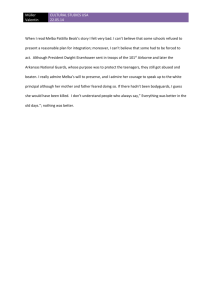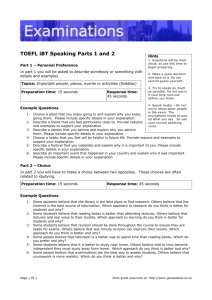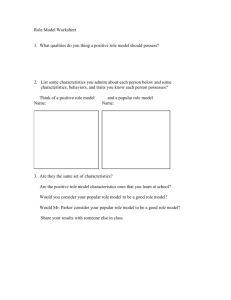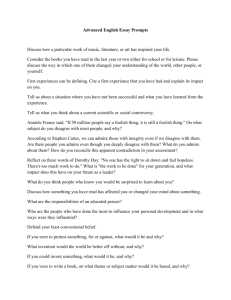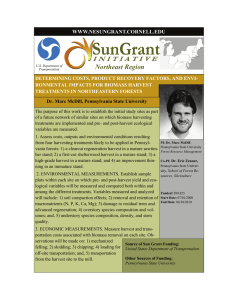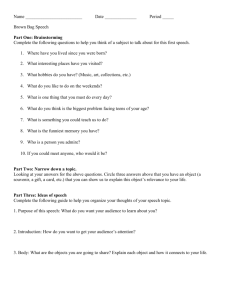EVALUATION OF GROWTH ENHANCEMENT ASSOCIATED WITH USE OF ADMIRE IN WATERMELON
advertisement
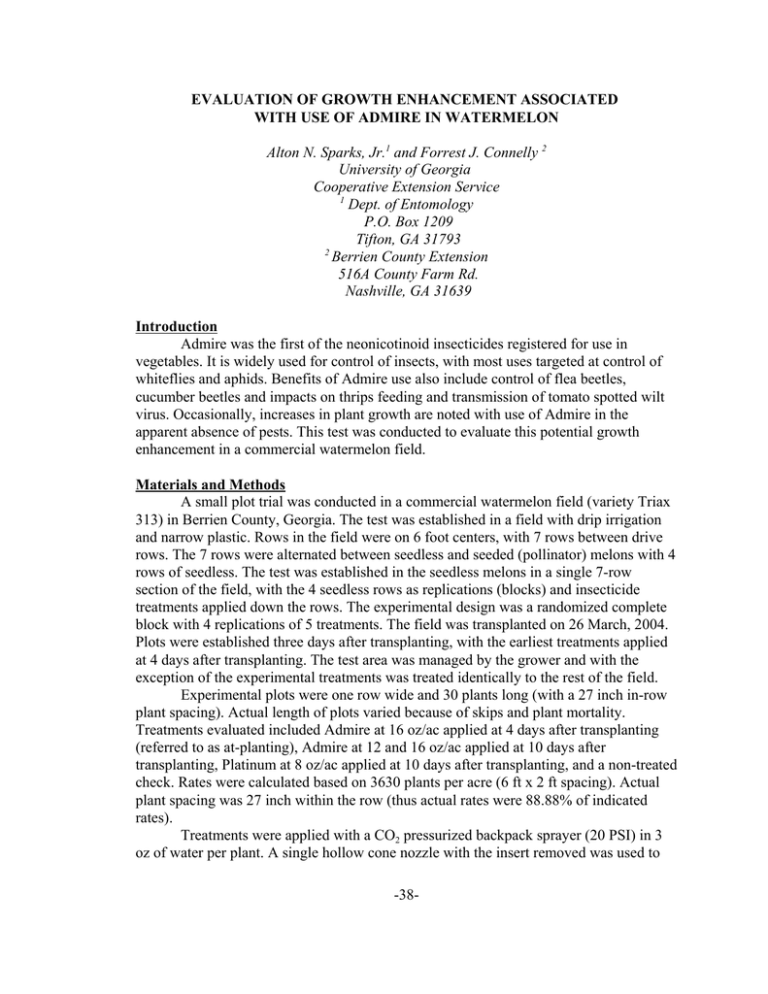
EVALUATION OF GROWTH ENHANCEMENT ASSOCIATED WITH USE OF ADMIRE IN WATERMELON Alton N. Sparks, Jr.1 and Forrest J. Connelly 2 University of Georgia Cooperative Extension Service 1 Dept. of Entomology P.O. Box 1209 Tifton, GA 31793 2 Berrien County Extension 516A County Farm Rd. Nashville, GA 31639 Introduction Admire was the first of the neonicotinoid insecticides registered for use in vegetables. It is widely used for control of insects, with most uses targeted at control of whiteflies and aphids. Benefits of Admire use also include control of flea beetles, cucumber beetles and impacts on thrips feeding and transmission of tomato spotted wilt virus. Occasionally, increases in plant growth are noted with use of Admire in the apparent absence of pests. This test was conducted to evaluate this potential growth enhancement in a commercial watermelon field. Materials and Methods A small plot trial was conducted in a commercial watermelon field (variety Triax 313) in Berrien County, Georgia. The test was established in a field with drip irrigation and narrow plastic. Rows in the field were on 6 foot centers, with 7 rows between drive rows. The 7 rows were alternated between seedless and seeded (pollinator) melons with 4 rows of seedless. The test was established in the seedless melons in a single 7-row section of the field, with the 4 seedless rows as replications (blocks) and insecticide treatments applied down the rows. The experimental design was a randomized complete block with 4 replications of 5 treatments. The field was transplanted on 26 March, 2004. Plots were established three days after transplanting, with the earliest treatments applied at 4 days after transplanting. The test area was managed by the grower and with the exception of the experimental treatments was treated identically to the rest of the field. Experimental plots were one row wide and 30 plants long (with a 27 inch in-row plant spacing). Actual length of plots varied because of skips and plant mortality. Treatments evaluated included Admire at 16 oz/ac applied at 4 days after transplanting (referred to as at-planting), Admire at 12 and 16 oz/ac applied at 10 days after transplanting, Platinum at 8 oz/ac applied at 10 days after transplanting, and a non-treated check. Rates were calculated based on 3630 plants per acre (6 ft x 2 ft spacing). Actual plant spacing was 27 inch within the row (thus actual rates were 88.88% of indicated rates). Treatments were applied with a CO2 pressurized backpack sprayer (20 PSI) in 3 oz of water per plant. A single hollow cone nozzle with the insert removed was used to -38- make applications. With the insert removed the nozzle sprayed a straight stream of water which was targeted at the base of the plant. The base of individual plants were treated with the entire 3 oz of spray for that plant (treatments were applied at the base of the plant with no treatment outside of this area). Applications were made on 30 March (4 days after transplanting) and 5 April (10 days after transplanting), 2004. Plant growth was monitored periodically through the season. Vine lengths were measured once early in the season (20 April) and visual ratings of canopy coverage were conducted twice (3 and 12 May). These data are not presented as no obvious differences were detected. Yields were collected from each plot by harvesting mature fruit on four dates. For the first three harvests, commercial harvest crews selected the melons for harvest. Melons from each plot were counted and weighed (generally weighed individually for the first harvest and two at a time thereafter). Yields were evaluated based on the number of fruit harvested per plot, the total weight of fruit harvested per plot, and the average weight of fruit (total weight/total number). All data were analyzed with the PROC GLM procedure of PC-SAS. Where significant differences were detected (P<0.05), means were separated with LSD (P=0.05). Results and Discussion No statistical differences occurred among treatments in the number or total weight of fruit harvested per plot on any single date, nor in cumulative yields across dates (Tables 1 and 2). Some differences in average fruit weight occurred in the third harvest (and a trend for differences in the fourth), but these differences were minor and did not consistently align with treatments (different admire treatments have the highest and lowest fruit weights in the third harvest, and the treatment with the highest weight in the third harvest has one of the lowest weights in the fourth harvest). Insecticide treatments in this test had minimal, if any, impact on plant growth and yields. A number of factors may have contributed to this including the slightly reduced rates as compared to the intended rates. Several other factors may also influence the potential growth response including application timing and methodology (plant drench concentrated at base of plant versus application through the drip system distributed along the row), amount applied per plant (equal per acre rates are higher per plant rates with a less dense stand), environment (moisture, heat, etc.), and plant species. While the growth response can be dramatic, it is inconsistent at best. Until the growth response, and factors influencing this response, are better understood, producers should be cautious about using Admire for reasons other than insect control. -39- Table 1. Number of watermelons harvested per plot, Admire growth enhancement test, Berrien County, Georgia, 2004. Treatment Average number of fruit harvested per plot 1st harvest 2nd harvest Cum. (1+2) 3rd harvest Cum. (1+2+3) 4th harvest Total Check 13.00 30.25 43.25 11.50 54.75 6.25 61.00 Platinum 11.75 29.50 41.25 10.50 51.75 8.50 60.25 Admire atplanting 13.50 31.00 44.50 8.75 53.25 6.75 60.00 Admire 12 oz. 10.25 34.25 44.50 12.50 57.00 8.00 65.00 Admire 16 oz. 11.25 32.75 44.00 9.00 53.00 8.75 61.75 No significant differences occurred among treatments for any of the data in this table. Table 2. Weight of watermelons harvested per plot, Admire growth enhancement test, Berrien County, Georgia, 2004. Treatment Average pounds of fruit harvested per plot 1st harvest 2nd harvest 3rd harvest Check 247.5 501.1 Platinum 228.1 Admire atplanting Admire 12 oz. 4th harvest (1+2+3) Total 748.6 165.9 914.4 86.3 1000.8 466.4 694.5 163.4 857.9 111.5 969.4 271.6 527.7 799.2 141.7 940.3 90.6 1030.8 193.7 581.8 775.5 176.9 952.4 119.1 1071.5 Cum. (1+2) Cum. Admire 16 oz. 218.5 547.7 766.1 132.7 898.8 120.0 1018.8 No significant differences occurred among treatments for any of the data in this table. -40- Table 3. Average weight of watermelons harvested, Admire growth enhancement test, Berrien County, Georgia, 2004. Treatment Average Fruit Weight (lbs/fruit) 1st harvest 2nd harvest 3rd harvest 4th harvest Check 19.26 a 16.28 a 14.83 bc 14.50 a Platinum 19.60 a 15.93 a 15.77 ab 12.79 a Admire at-planting 19.87 a 16.73 a 16.35 a 13.21 a Admire 12 oz. 19.12 a 16.83 a 14.24 c 14.19 a Admire 16 oz. 19.53 a 16.75 a 15.15 abc 15.04 a Numbers within columns followed by the same letter are not significantly different (LSD, P=0.05). -41-
